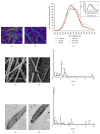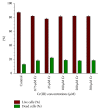Role of Geitlerinema sp. DE2011 and Scenedesmus sp. DE2009 as Bioindicators and Immobilizers of Chromium in a Contaminated Natural Environment
- PMID: 26167488
- PMCID: PMC4488086
- DOI: 10.1155/2015/519769
Role of Geitlerinema sp. DE2011 and Scenedesmus sp. DE2009 as Bioindicators and Immobilizers of Chromium in a Contaminated Natural Environment
Abstract
The aim of this work was to study the potential of the two phototrophic microorganisms, both isolated from Ebro Delta microbial mats, to be used as bioindicators and immobilizers of chromium. The results obtained indicated that (i) the Minimum Metal Concentration (MMC) significantly affecting Chlorophyll a intensity in Geitlerinema sp. DE2011 and Scenedesmus sp. DE2009 was 0.25 µM and 0.75 µM, respectively, these values being lower than those established by current legislation, and (ii) Scenedesmus sp. DE2009 was able to immobilize chromium externally in extracellular polymeric substances (EPS) and intracellularly in polyphosphate (PP) inclusions. Additionally, this microorganism maintained high viability, including at 500 µM. Based on these results, we postulate that Geitlerinema sp. DE2011 and Scenedesmus sp. DE2009 are good chromium-indicators of cytotoxicity and, further, that Scenedesmus sp. DE2009 plays an important role in immobilizing this metal in a contaminated natural environment.
Figures





Similar articles
-
Effect of copper and lead on two consortia of phototrophic microorganisms and their capacity to sequester metals.Aquat Toxicol. 2013 Sep 15;140-141:324-36. doi: 10.1016/j.aquatox.2013.06.022. Epub 2013 Jul 8. Aquat Toxicol. 2013. PMID: 23891781
-
Combined Confocal Laser Scanning Microscopy Techniques for A Rapid Assessment of the Effect and Cell Viability of Scenedesmus sp. DE2009 Under Metal Stress.Microsc Microanal. 2019 Aug;25(4):998-1003. doi: 10.1017/S143192761901465X. Epub 2019 Jun 24. Microsc Microanal. 2019. PMID: 31232262
-
Selection of bioindicators to detect lead pollution in Ebro delta microbial mats, using high-resolution microscopic techniques.Aquat Toxicol. 2011 Jul;104(1-2):135-44. doi: 10.1016/j.aquatox.2011.04.009. Epub 2011 Apr 22. Aquat Toxicol. 2011. PMID: 21570936
-
Ecotoxicity study of titania (TiO₂) NPs on two microalgae species: Scenedesmus sp. and Chlorella sp.Ecotoxicol Environ Saf. 2011 Jul;74(5):1180-7. doi: 10.1016/j.ecoenv.2011.03.006. Epub 2011 Apr 8. Ecotoxicol Environ Saf. 2011. PMID: 21481931
-
Mechanistic insights into the potential application of Scenedesmus strains towards the elimination of antibiotics from wastewater.Bioresour Technol. 2024 Oct;410:131289. doi: 10.1016/j.biortech.2024.131289. Epub 2024 Aug 15. Bioresour Technol. 2024. PMID: 39153695 Review.
Cited by
-
Versatility of the green microalga cell vacuole function as revealed by analytical transmission electron microscopy.Protoplasma. 2017 May;254(3):1323-1340. doi: 10.1007/s00709-016-1024-5. Epub 2016 Sep 27. Protoplasma. 2017. PMID: 27677801
-
Morphological responses to nitrogen stress deficiency of a new heterotrophic isolated strain of Ebro Delta microbial mats.Protoplasma. 2019 Jan;256(1):105-116. doi: 10.1007/s00709-018-1263-8. Epub 2018 Jul 9. Protoplasma. 2019. PMID: 29987389
-
Effect of Metals, Metalloids and Metallic Nanoparticles on Microalgae Growth and Industrial Product Biosynthesis: A Review.Int J Mol Sci. 2015 Oct 9;16(10):23929-69. doi: 10.3390/ijms161023929. Int J Mol Sci. 2015. PMID: 26473834 Free PMC article. Review.
References
Publication types
MeSH terms
Substances
LinkOut - more resources
Full Text Sources
Other Literature Sources
Miscellaneous

